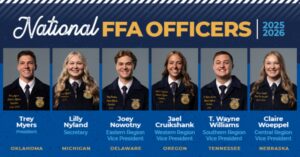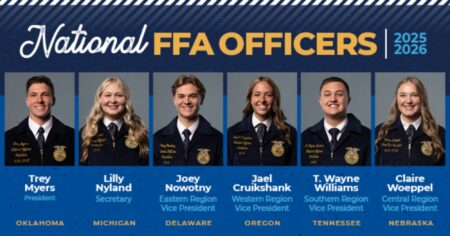New innovations aim to boost demand for these crops by using them to help revolutionize industries and deliver sustainable solutions for everyday life.
Animal agriculture is still the top market for soybeans, consuming 33 million metric tons annually. Corn also plays a leading role in livestock feed, as well as ethanol production. But in addition to those mainstays, corn and soy are now showing up in unexpected places such as textiles, tires, plastics, and even as a skin substitute for burn victims.
Carla Schultz farms in Michigan’s Thumb and sees the benefits of soybean meal to her farm’s pork and poultry rations. She also sees the potential of biofuels and soy-based products. “Obviously, feed is a big piece of the pie chart,” she said. “But it’s important to stay diversified in your portfolio, because you never know where potential might break out.”
More Than a Bean
“Soy is a really versatile feedstock,” said Brian Pierce, senior vice president of strategic investment processes for the United Soybean Board (USB), which administers farmers’ soybean checkoff investments. “There’s a lot of interest in a readily available, sustainable crop that can be used as a raw material in the supply chain.”
Healing With Soy
Perhaps one of the most groundbreaking uses of soy comes from NeuEsse, a biotech company that created a human skin substitute made from soy protein.
OmegaSkin is a scaffold dressing for patients who have suffered wounds, burns, skin-disrupting ulcers, and other skin/epidermal injuries, said Joe Connell, founder and CEO. He explained that unlike other treatments made from cadavers, pigs, or cows, soy skin integrates into the body, helping patients regenerate real skin, complete with functioning hair follicles and sweat glands.
“The soy skin becomes your body,” Connell explained. “It never comes out. You don’t face ripping a scab off because the bandage adhered to what you’re trying to heal.”
This product, which is in the final stages of U.S. Food and Drug Administration approval, is personal for Connell, who suffered severe burns in his youth that required 360 deep circles of skin from his thigh to rebuild his leg. “That caused 360 new wounds that resulted in 360 new scars,” he said. “My mission in bringing this soy skin is to prevent as many people as possible from enduring painful skin grafting. That’s my pay-it-forward mission.”
Peter von Kahle
From the Field to the Firehouse
The USB, farmers, researchers, and private companies are teaming up to create sustainable alternatives for a variety of products such as Cross Plains Solutions’ SoyFoam TF 1122. The company says this soy-based firefighting foam is entirely free of per- and polyfluoroalkyl substances (PFAS), known as “forever chemicals,” and is 100% biodegradable. The product allows departments flexibility to use it for training as well as active firefighting, said Steve Reinhard, a farmer from Bucyrus, Ohio, the past USB chair and a volunteer firefighter. “I like to call this a triple win,” he said. “It’s good for our first responders, it’s good for the environment, and we sell soybeans in the process.”
SoyFoam is approved for Class A (ordinary combustible) and Class B (flammable liquid) fires, with further certifications underway for broader use, including wildfires. “I think this is going to be a great product to fight wildfires with the way it coats and extinguishes the flame,” Reinhard said.
Across the nation, about 50 fire departments have switched to SoyFoam. Many more have taken samples to begin their own evaluation. The first rollout has the potential to utilize more than 12 million bushels of soybeans, Reinhard said.
Powering Performance
Goodyear began incorporating soybean oil into tires about six years ago, starting with the tire tread, Pierce said, adding the company’s goal is to eliminate petroleum use in tires by 2040. Today, 11 lines of Goodyear tires feature soybean oil, including those for police cruisers, fire trucks, trash trucks, and buses. Soy offers a unique advantage over petroleum by helping tire treads stay flexible in cold weather and stable in heat, enabling all-weather performance and earning the prestigious “Three-Peak Mountain Snowflake” rating, Pierce said.
“I just took a 15-hour road trip with my family, all on Goodyear’s soy-based tires,” he said. “They performed great, and I trusted my family’s safety to them.”
USB continues to work with Goodyear to expand soy use in other tire components, highlighting the functionality and sustainability soy offers over petroleum, Pierce said.
Also, Skechers has licensed this technology from Goodyear for use in their shoe soles.
Another product making waves is DeWalt’s soy-based bar and chain oil, developed in partnership with Dynamic Green Products. The formula offers a sustainable, biodegradable alternative to petroleum oils. “We wanted a product that was environmentally friendly,” Reinhard explained. “As the chain goes around, the oil is getting flung off and is totally consumed by the environment.”
The soy-based line has also grown under brands such as Stanley Black & Decker and Craftsman, with additional soy-based cleaners and lubricants available.
Cutting-Edge Corn
The Iowa Corn Promotion Board is at the forefront of corn innovation, investing checkoff funds into research for new uses for the crop. “We do not see anyone better to work on developing projects because we truly have the farmer in mind,” said Alex Buck, director of industrial innovation for Iowa Corn. “Our No. 1 objective for new uses is to increase corn demand or grind more corn.”
Iowa Corn fills a gap in corn innovation research by focusing on projects in early development. As a checkoff organization, Iowa Corn is able to develop projects to increase their probability of success, and then license or sell to third parties for commercialization, Buck said.
Corn Clothes
Corn presents a unique opportunity for the textile industry, offering synthetic fabric production with a lower environmental impact than its petroleum counterparts.
“The textile industry, in general, has a view of agriculture focused on cotton and animal fibers,” Buck said. “But synthetics are the largest feedstock of the textile industry over natural fibers, so corn can be a plant-based replacement.”
Qore, a joint venture between Cargill and Helm Agro, looks to use corn sugar to produce 1,4-butanediol (BDO). The plant-based product can be used to make spandex, athletic wear, shoe soles, and more. Qore aims to have the product available next year, and estimates the use of the plant-based BDO could save 93% of greenhouse gas emissions compared with conventional BDO.
Plant Plastics
Corn-based plastics could answer the demand for renewable materials at a cost that’s competitive with petroleum. The production of monoethylene glycol (MEG) from corn sugar was a major focus of Iowa Corn-funded research. In 2022, Iowa Corn sold its patents, technology, and knowledge to Technip Energies, a French engineering company, in the hopes of growing the market.
Corn-based MEG, also known as bio-MEG, has yet to be commercialized, although developments are underway. A plant using different technology is under construction in Indiana, with plans to produce soda bottles, water bottles, and polyester clothes with bio-MEG, Buck said.
Iowa Corn reports more than 75 billion pounds of fossil fuel-based MEG are used globally each year, with market growth equating to nearly 100 million bushel equivalents of corn. Bio-MEG production also would reduce the need for fossil fuels, meeting consumer demand for plastics with a lower environmental impact.
From Farm to Foam
Iowa Corn’s most recent project looks to develop corn-based vinyl acetate monomer (VAM), a product used in everything from Crocs and flip-flops to pool kickboards and yoga mats. Initial research found 18.5 billion pounds of VAM are produced annually from fossil fuels, growing at 22 million equivalents per year.
While in the early stages of development, Iowa Corn has screened more than 30 new catalysts — an essential part of the chemical reaction that produces VAM — and filed six provisional patents. Iowa Corn aims to engage with commercial partners and produce polymer-grade VAM by the project’s conclusion in August 2027. The venture has received funding from corn checkoffs in Kentucky, Michigan, Nebraska, North Dakota, South Dakota, and Wisconsin.
Meredith Operations Corp.
Why New Products Matter
Steve Nicholson, global sector strategist on grains and oilseeds for Rabo AgriFinance, said these new and novel uses for corn and soybeans matter because many of the traditional demand sources are flattening or have flattened.
“And so the question is: Where does the new demand come [from]?” he said. “We continue to produce bigger crops.… We have to increase the demand, so we can keep price in a place where it’s profitable for farmers to produce.”
Furthermore, research by Terrain, a team of economic analysts working on behalf of several Farm Credit associations, concludes the global population will peak at 9.38 billion sometime between 2065 and 2070. According to their research series, “The Big Shrink,” this population shift will impact demand for commodities. “Whether the timing of peak population is exact or not, the reality of a sustained contraction is incredibly profound, as humanity has never consistently been in population decline,” said one of The Big Shrink research papers, “How Will Agriculture Navigate the Baby Bust?”
“We have built a production capacity in the world agriculturally to feed 10 billion people by 2050,” Nicholson said. “What do we do with all this production capacity if all those people don’t show up?”
One of the series’ conclusions is the agricultural industry needs to shift from the “feed the world” mindset, through bulk commodity exports, to adding value to commodities by processing them into new products that will be in demand at home and abroad.
Innovations and new products, like the ones in the works today, lead to a higher value for the crops they’re made from, according to Matt Clark, senior rural economy analyst at Terrain. “In theory,” he said, “if you work this all the way back, that’s going back to the basis you get on your corn.”
Demand Trends
The tables below show the compound annual growth rate (CAGR) for corn and soybean demand. The domestic table shows how domestic corn demand has declined over the past 40 years while soybean demand has increased. The table covering exports shows the inverse, with corn demand increasing and soybean demand shrinking. Steve Nicholson, global sector strategist on grains and oilseeds for Rabo AgriFinance, said while corn export demand has grown, the global trade environment is “worrisome,” as the U.S. is becoming a residual supplier and Brazil is rising as the leading global supplier.
| Total Domestic Consumption | ||
|---|---|---|
| CAGR | Corn | Soybeans |
| 40-year | 2.25% | 2.06% |
| 20-year | 1.80% | 1.48% |
| 10-year | 0.62% | 2.29% |
| Total Exports | ||
|---|---|---|
| CAGR | Corn | Soybeans |
| 40-year | 0.81% | 2.83% |
| 20-year | 1.71% | 2.58% |
| 10-year | 3.17% | -0.09% |


:max_bytes(150000):strip_icc()/Markets-1-Soybeans-field-dramatic-up-14-5283b95420d5449fbb4c6ffaa3fa212f.jpeg)
:max_bytes(150000):strip_icc()/10621203553_e4184253b6_o-676ad5aadaf34ba5ac4d51a79d251c1f.jpeg)



:max_bytes(150000):strip_icc()/GoodyearsoytireUSB-e8fa7426d03042ebb0dc57583ea6f40a.jpeg)

:max_bytes(150000):strip_icc()/52513708671_2a6075fabe_o-dcd59efb1faf4c40afb3d8f39629aa7d.jpg)
:max_bytes(150000):strip_icc()/JaceYoung-ee4a04deb5fe4fbfa816744f027fcda5.jpg)
:max_bytes(150000):strip_icc()/pumpkins-_-cami-koons-2048x1545-b706ebeeace44615adaef29ad2c99f39.jpg)